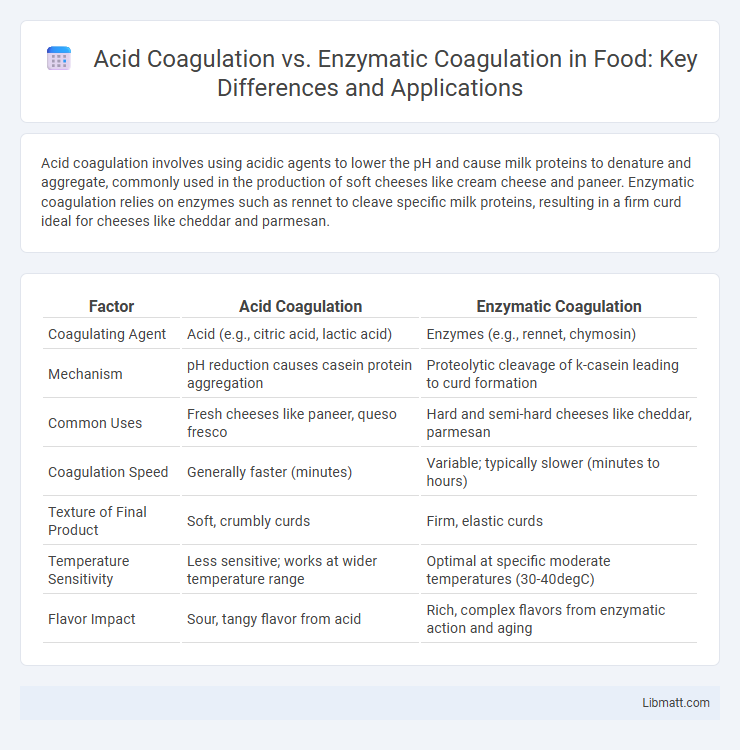Acid coagulation involves using acidic agents to lower the pH and cause milk proteins to denature and aggregate, commonly used in the production of soft cheeses like cream cheese and paneer. Enzymatic coagulation relies on enzymes such as rennet to cleave specific milk proteins, resulting in a firm curd ideal for cheeses like cheddar and parmesan.
Table of Comparison
| Factor | Acid Coagulation | Enzymatic Coagulation |
|---|---|---|
| Coagulating Agent | Acid (e.g., citric acid, lactic acid) | Enzymes (e.g., rennet, chymosin) |
| Mechanism | pH reduction causes casein protein aggregation | Proteolytic cleavage of k-casein leading to curd formation |
| Common Uses | Fresh cheeses like paneer, queso fresco | Hard and semi-hard cheeses like cheddar, parmesan |
| Coagulation Speed | Generally faster (minutes) | Variable; typically slower (minutes to hours) |
| Texture of Final Product | Soft, crumbly curds | Firm, elastic curds |
| Temperature Sensitivity | Less sensitive; works at wider temperature range | Optimal at specific moderate temperatures (30-40degC) |
| Flavor Impact | Sour, tangy flavor from acid | Rich, complex flavors from enzymatic action and aging |
Introduction to Milk Coagulation
Milk coagulation transforms liquid milk into curds, essential for cheese production, through acid or enzymatic methods. Acid coagulation lowers milk's pH, causing casein proteins to aggregate, while enzymatic coagulation uses rennet enzymes like chymosin to cleave casein, forming a firmer curd. Your choice between these methods impacts cheese texture, flavor, and production time, crucial for optimizing dairy processing.
Understanding Acid Coagulation
Acid coagulation involves the denaturation of milk proteins by lowering the pH, typically using lactic acid bacteria or direct acid addition, which causes casein micelles to lose their stability and aggregate into a gel. This method differs from enzymatic coagulation, where enzymes like rennet specifically cleave kappa-casein to trigger curd formation. Understanding acid coagulation is essential for optimizing texture and flavor in products like yogurt and certain soft cheeses, affecting your control over the fermentation process and final dairy quality.
Understanding Enzymatic Coagulation
Enzymatic coagulation involves the use of specific proteolytic enzymes, primarily rennet containing chymosin, to cleave casein proteins and form a firm curd essential in cheese production. This process differs from acid coagulation, which relies on pH reduction to precipitate proteins, resulting in a softer texture and distinct flavor profile. Understanding enzymatic coagulation helps you optimize cheese yield and texture by controlling factors like enzyme concentration, temperature, and coagulation time.
Mechanisms of Acid-Induced Coagulation
Acid-induced coagulation occurs when lowering pH causes casein micelles in milk to lose their surface charge, leading to destabilization and aggregation. This process primarily involves the neutralization of negative charges on casein, promoting protein-protein interactions and the formation of a gel network. In contrast, enzymatic coagulation uses proteolytic enzymes like rennet to specifically hydrolyze kappa-casein, releasing para-casein which aggregates, making acid coagulation a pH-driven mechanism while enzymatic coagulation is enzyme-specific hydrolysis.
Mechanisms of Enzyme-Induced Coagulation
Enzyme-induced coagulation primarily involves the action of proteolytic enzymes, such as chymosin, which specifically cleave casein proteins in milk, leading to the destabilization of micelles and the formation of a gel network. This mechanism contrasts with acid coagulation, where lowering the pH causes casein precipitation by reducing electrostatic repulsion. Understanding enzymatic mechanisms helps you optimize processes in cheese production, enhancing texture and yield.
Key Differences Between Acid and Enzymatic Coagulation
Acid coagulation involves lowering milk pH to isoelectric point 4.6, causing casein proteins to precipitate and form curds, commonly used in products like paneer and cream cheese. Enzymatic coagulation utilizes proteolytic enzymes such as rennet, which specifically cleave k-casein, leading to a firmer curd structure essential in traditional cheese-making processes like cheddar and mozzarella. Acid coagulation results in a softer, more crumbly texture, while enzymatic coagulation produces a denser, more elastic texture with enhanced flavor development due to proteolysis during ripening.
Applications in Cheese Making
Acid coagulation is primarily used in the production of fresh cheeses like paneer and cream cheese, where lactic acid bacteria or direct acid addition lowers the pH to coagulate the milk proteins. Enzymatic coagulation, driven by rennet containing chymosin, is essential in making firm cheeses such as cheddar, gouda, and parmesan, as it cleaves casein molecules to form a strong curd structure. Your choice between these methods depends on the desired texture and flavor profile, with enzymatic coagulation offering more control over aging and ripening characteristics.
Texture and Flavor Impact
Acid coagulation produces a softer, more crumbly texture with a tangy, acidic flavor profile often found in fresh cheeses like ricotta and paneer. Enzymatic coagulation, using enzymes such as rennet, yields a firmer, more elastic curd and a complex, mellow flavor typical of aged cheeses like cheddar and gouda. The choice between acid and enzymatic coagulation significantly influences cheese texture, moisture content, and flavor development during maturation.
Factors Influencing Coagulation Methods
Factors influencing acid coagulation include pH levels, temperature, and milk composition, such as protein and mineral content, which affect casein micelle destabilization and curd formation. Enzymatic coagulation relies heavily on enzyme concentration, temperature, and milk freshness, as optimal conditions are necessary for enzyme-substrate interaction and effective proteolysis of kappa-casein. The choice between acid and enzymatic methods often depends on desired cheese texture, coagulation time, and specific milk properties that influence curd firmness and yield.
Choosing the Right Coagulation Technique
Selecting the appropriate coagulation technique depends on the desired texture, flavor, and production process of the dairy product. Acid coagulation, commonly used for fresh cheeses like cottage cheese and cream cheese, produces a softer, tangier texture by lowering pH and denaturing proteins. Enzymatic coagulation, primarily using rennet, results in firmer curds ideal for aged cheeses by specifically cleaving casein proteins and facilitating whey separation.
acid coagulation vs enzymatic coagulation Infographic

 libmatt.com
libmatt.com